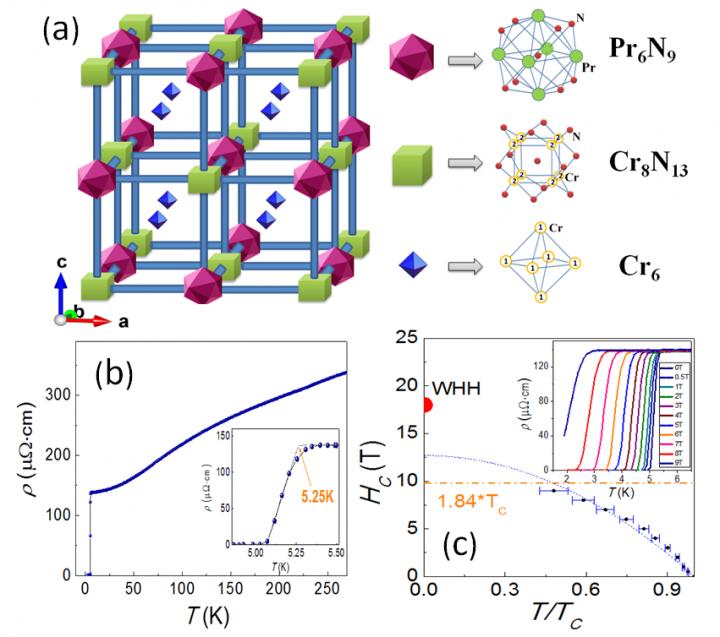The first Cr-based nitrides superconductor Pr3Cr10-xN11

(a) The face-centered cubic cell of Pr3Cr10-xN11 with three kinds of building blocks: Pr6N9, Cr8N13 and Cr6, respectively. (b) Temperature dependence of the resistivity for Pr3Cr10-xN11 from 1.8 to 300 K at the zero field. (c) The temperature dependence of the upper critical magnetic field. The inset shows the temperature dependence of the resistivity at different fields. Credit: ©Science China Press
Among the 3d transitional metallic compounds, the Cr and Mn based materials can hardly become superconducting due to robust static magnetism which can destroy the superconductivity. Following the discovery of superconductivity in CrAs, a search for new chromium based superconducting materials was conducted.
Recently, quasi one-dimensional A2Cr3As3 and ACr3As3 (A =Na, K, Rb, Cs) were reported in other arsenide materials. Exploration of those quasi one-dimensional superconductor is a hot spot primarily owing to their reduced dimensionality, significant electron correlations, and possible unconventional superconductivity.
Recently, Wei Wu, Jianlin Luo et al. from Institute of Physics, Chinese Academy of Sciences, and Kai Liu from Renmin University of China now report the discovery of the first Cr-based Nitrides superconductor of Pr3Cr10-xN11 with cubic structure.
Pr3Cr10-xN11 was first synthesized and characterized by Broil et al. in 1995. The compound crystallizes in space group Fm-3m (No. 225) with lattice constant a = 12.891 Å. It contains 192 atoms in a face-centered cubic (FCC) unit cell with 3 kinds of building blocks as illustrated in Fig (a).
The electrical resistivity [Fig (b)], magnetization and specific heat of Pr3Cr10-xN11 show bulk superconductivity at 5.25 K. The superconductivity in Pr3Cr10-XN11 shows several distinct characters. A relatively large upper critical field is found at the zero-temperature limit, Hc2(0) ~ 12.6 T, which is larger than the Pauli limit for paramagnetic pair-breaking field as shown in Fig (c).
The material has a large electronic specific-heat coefficient of 170 mJ K-2 mol-1, about 10 times larger than that estimated by the electronic structure calculation, which suggests that correlations between 3d electrons is very strong in Pr3Cr10-xN11, and thus quantum fluctuations might be involved.
From electronic structure calculations, the density of states at the Fermi energy is predominately contributed by Cr 3d electrons. This result demonstrates that Pr3Cr10-xN11 is the first Cr-based superconductor discovered in Chromium Nitrides and it represents a rare example that possibly unconventional superconductivity emerges in a 3D system with strong electron correlations.
###
See the article:
Wei Wu, Kai Liu, Yanjie Li, Zhenhai Yu, Desheng Wu, Yuting Shao, Shihang Na, Gang Li, Ruizhen Huang, Tao Xiang and Jianlin Luo
Superconductivity in Chromium Nitrides Pr3Cr10-xN11 with Strong Electron Correlations
https:/
Media Contact
More Information:
http://dx.doi.org/10.1093/nsr/nwz129All latest news from the category: Power and Electrical Engineering
This topic covers issues related to energy generation, conversion, transportation and consumption and how the industry is addressing the challenge of energy efficiency in general.
innovations-report provides in-depth and informative reports and articles on subjects ranging from wind energy, fuel cell technology, solar energy, geothermal energy, petroleum, gas, nuclear engineering, alternative energy and energy efficiency to fusion, hydrogen and superconductor technologies.
Newest articles

Silicon Carbide Innovation Alliance to drive industrial-scale semiconductor work
Known for its ability to withstand extreme environments and high voltages, silicon carbide (SiC) is a semiconducting material made up of silicon and carbon atoms arranged into crystals that is…

New SPECT/CT technique shows impressive biomarker identification
…offers increased access for prostate cancer patients. A novel SPECT/CT acquisition method can accurately detect radiopharmaceutical biodistribution in a convenient manner for prostate cancer patients, opening the door for more…

How 3D printers can give robots a soft touch
Soft skin coverings and touch sensors have emerged as a promising feature for robots that are both safer and more intuitive for human interaction, but they are expensive and difficult…





















